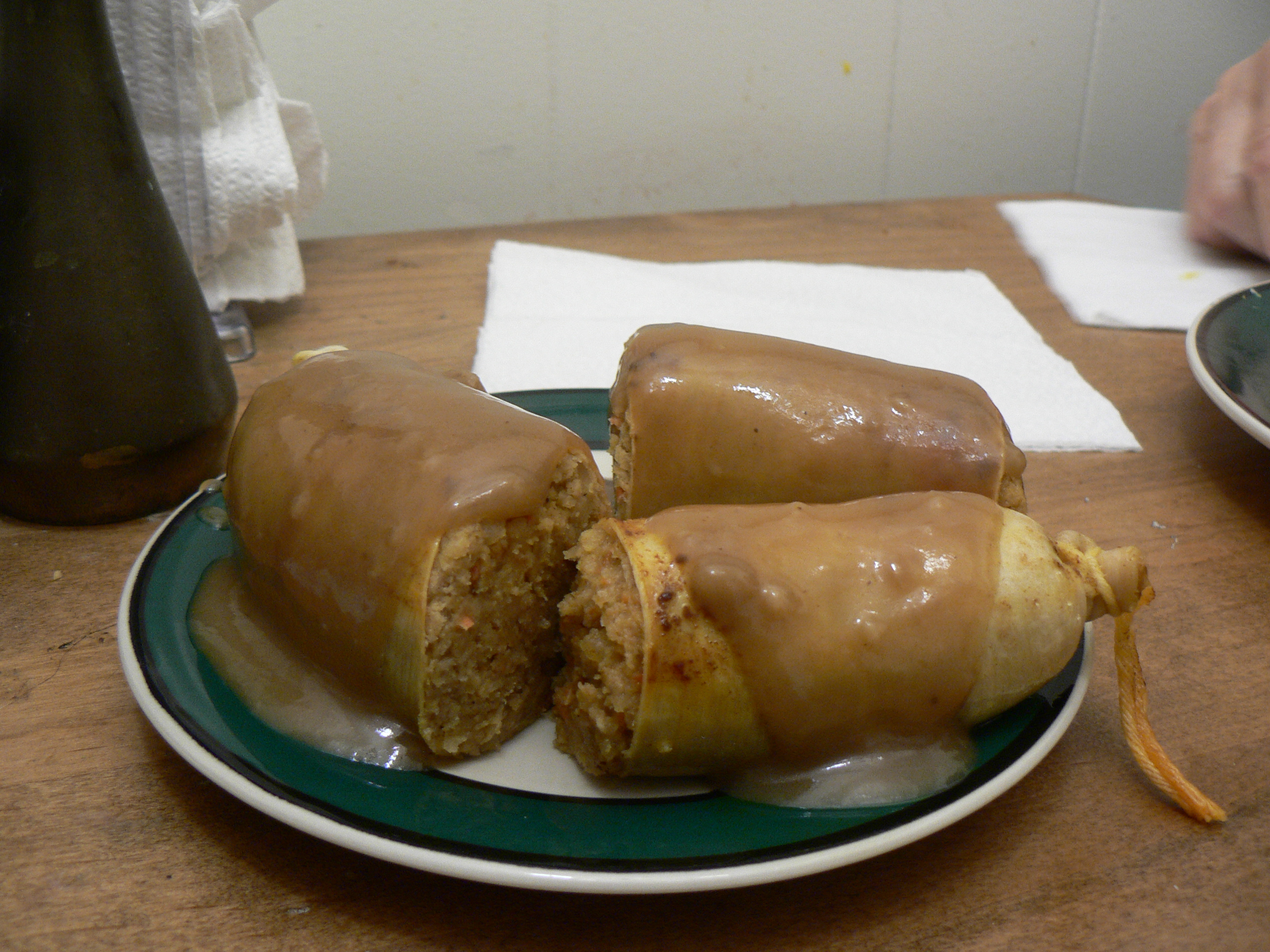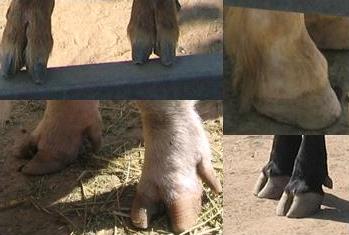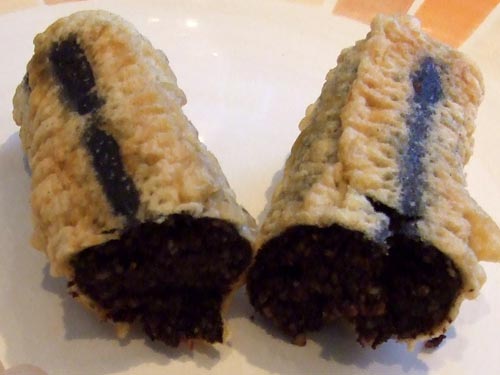|
Kishka (food)
Kishka or kishke (Belarusian language, Belarusian: кішка, ''kishka'' ; Czech language, Czech: ''jelito'' ; Slovak language, Slovak: ''krvavnica'' (regionally also ''hurka''); ; Romanian language, Romanian: ''chişcă''; Yiddish language, Yiddish: קישקע : kishke; Hebrew language, Hebrew קישקע; Russian language, Russian: ''кишка'' ; Ukrainian language, Ukrainian: ''кишка'' ; also ; Lithuanian language, Lithuanian: ''vėdarai''; Hungarian language, Hungarian: ''hurka'' ) refers to various types of sausage or stuffed intestine with a filling made from a combination of meat and meal, often grain or potato. The dish is popular across Eastern Europe as well as with immigrant communities from those areas. It is also eaten by Ashkenazi Jews who prepare their version according to kashrut dietary laws. The name is Slavic languages, Slavic in origin, and literally means "gut" or "intestine". It may be related to the Ancient Greek word κύστις (kystis), "bladder ... [...More Info...] [...Related Items...] OR: [Wikipedia] [Google] [Baidu] |
Kashrut
(also or , ) is a set of Food and drink prohibitions, dietary laws dealing with the foods that Jewish people are permitted to eat and how those foods must be prepared according to halakha, Jewish law. Food that may be consumed is deemed kosher ( in English, ), from the Ashkenazi Hebrew, Ashkenazi pronunciation of the term that in Sephardi Hebrew, Sephardi or Modern Hebrew is pronounced ''kashér'' (), meaning "fit" (in this context: "fit for consumption"). Food that may not be consumed, however, is deemed treif ( in English, ), also spelled treyf (). In case of objects the opposite of kosher is pasúl ( in English, Yiddish: פָּסוּל). Although the details of the laws of are numerous and complex, they rest on a few basic principles: * Only certain types of mammals, birds, and fish, Kosher animals, meeting specific criteria are kosher; the consumption of the flesh of any animals that do not meet these criteria, such as pork, frogs, and shellfish, is forbidden, except ... [...More Info...] [...Related Items...] OR: [Wikipedia] [Google] [Baidu] |
Kosher
(also or , ) is a set of dietary laws dealing with the foods that Jewish people are permitted to eat and how those foods must be prepared according to Jewish law. Food that may be consumed is deemed kosher ( in English, ), from the Ashkenazi pronunciation of the term that in Sephardi or Modern Hebrew is pronounced ''kashér'' (), meaning "fit" (in this context: "fit for consumption"). Food that may not be consumed, however, is deemed treif ( in English, ), also spelled treyf (). In case of objects the opposite of kosher is pasúl ( in English, Yiddish: פָּסוּל). Although the details of the laws of are numerous and complex, they rest on a few basic principles: * Only certain types of mammals, birds, and fish, meeting specific criteria are kosher; the consumption of the flesh of any animals that do not meet these criteria, such as pork, frogs, and shellfish, is forbidden, except for locusts, which are the only kosher invertebrate. * The most basic eating rule in ... [...More Info...] [...Related Items...] OR: [Wikipedia] [Google] [Baidu] |
Midwest
The Midwestern United States (also referred to as the Midwest, the Heartland or the American Midwest) is one of the four census regions defined by the United States Census Bureau. It occupies the northern central part of the United States. It was officially named the North Central Region by the U.S. Census Bureau until 1984. It is between the Northeastern United States and the Western United States, with Canada to the north and the Southern United States to the south. The U.S. Census Bureau's definition consists of 12 states in the north central United States: Illinois, Indiana, Iowa, Kansas, Michigan, Minnesota, Missouri, Nebraska, North Dakota, Ohio, South Dakota, and Wisconsin. The region generally lies on the broad Interior Plain between the states occupying the Appalachian Mountain range and the states occupying the Rocky Mountain range. Major rivers in the region include, from east to west, the Ohio River, the Upper Mississippi River, and the Missouri River. The 20 ... [...More Info...] [...Related Items...] OR: [Wikipedia] [Google] [Baidu] |
Vegetarian
Vegetarianism is the practice of abstaining from the Eating, consumption of meat (red meat, poultry, seafood, insects as food, insects, and the flesh of any other animal). It may also include abstaining from eating all by-products of animal slaughter. A person who practices vegetarianism is known as a vegetarian. Vegetarianism may be adopted for various reasons. Many people ethics of eating meat, object to eating meat out of respect for Sentience, sentient animal life. Such ethical motivations have been codified vegetarianism and religion, under various religious beliefs as well as animal rights advocacy. Other motivations for vegetarianism are health-related, political, Environmental vegetarianism, environmental, cultural, aesthetic, Economic vegetarianism, economic, gastronomy, taste-related, or relate to other personality psychology, personal preferences. A small number of towns and cities around the world are exclusively vegetarian or have outlawed meat, including Rishikesh ... [...More Info...] [...Related Items...] OR: [Wikipedia] [Google] [Baidu] |
Ingredient
In a general sense, an ingredient is a substance which forms part of a mixture. In cooking, recipes specify which ingredients are used to prepare a dish, and the term may also refer to a specific food item in relation to its use in different recipes. Many commercial products contain secret ingredients purported to make them better than competing products. In the pharmaceutical industry, an active ingredient is the ingredient in a Pharmaceutical formulation, formulation which invokes biological activity. National laws usually require prepared food products to display a list of ingredients and specifically require that certain food additive, additives be listed. Law typically requires that ingredients be listed according to their relative weight within the product. Etymology From Middle French , from Latin , present participle of ('to go or enter into or onto'). Artificial ingredient An artificial ingredient usually refers to an ingredient which is wikt:artificial, artifici ... [...More Info...] [...Related Items...] OR: [Wikipedia] [Google] [Baidu] |
Paprika
Paprika is a spice made from dried and ground red peppers, traditionally ''capsicum annuum''. It can have varying levels of Pungency, heat, but the peppers used for hot paprika tend to be milder and have thinner flesh than those used to produce chili powder. The milder, sweet paprika is mostly composed of the fruit of the pepper with most of the seeds removed; whereas some seeds and stalks are retained in the peppers used for hotter paprika. Paprika, like all capsicum varieties and their derivatives, is descended from wild ancestors from the Amazon River, cultivated in ancient times in South, Central and North America, in particular Mexican Plateau, central Mexico. The peppers were introduced to Europe, via Spanish Empire, Spain and Portuguese Empire, Portugal, in the sixteenth century. The trade in paprika expanded from the Iberian Peninsula to Africa and Asia and ultimately reached central Europe through the Balkans. European cuisines in which paprika is a frequent and major ... [...More Info...] [...Related Items...] OR: [Wikipedia] [Google] [Baidu] |
Black Pudding
Black pudding is a distinct national type of blood sausage originating in the United Kingdom and Ireland. It is made from pork or occasionally beef Blood as food, blood, with Lard, pork fat or Suet, beef suet, and a cereal, usually oatmeal, oat groats, or barley groats. The high proportion of cereal, along with the use of certain herbs such as Mentha pulegium, pennyroyal, serves to distinguish black pudding from blood sausages eaten in other parts of the world.Jaine, T. and Davidson, A. ''The Oxford companion to food'', OUP, 2006, p.104 Etymology The word ''wikt:pudding, pudding'' is believed to derive from the French , originally from the Latin , meaning "small sausage". History and recipes Blood puddings are often considered to be one of the oldest forms of sausage. Animals are generally bled at slaughter, and as blood rapidly spoils unless prepared in some way, making a pudding with it is one of the easiest ways of ensuring it does not go to waste. While the majority of mode ... [...More Info...] [...Related Items...] OR: [Wikipedia] [Google] [Baidu] |
Barley
Barley (), a member of the grass family, is a major cereal grain grown in temperate climates globally. It was one of the first cultivated grains; it was domesticated in the Fertile Crescent around 9000 BC, giving it nonshattering spikelets and making it much easier to harvest. Its use then spread throughout Eurasia by 2000 BC. Barley prefers relatively low temperatures and well-drained soil to grow. It is relatively tolerant of drought and soil salinity, but is less winter-hardy than wheat or rye. In 2023, barley was fourth among grains in quantity produced, 146 million tonnes, behind maize, rice, and wheat. Globally, 70% of barley production is used as animal feed, while 30% is used as a source of fermentable material for beer, or further distilled into whisky, and as a component of various foods. It is used in soups and stews and in barley bread of various cultures. Barley grains are commonly made into malt using a traditional and ancient method of preparatio ... [...More Info...] [...Related Items...] OR: [Wikipedia] [Google] [Baidu] |
Buckwheat
Buckwheat (''Fagopyrum esculentum'') or common buckwheat is a flowering plant in the knotweed family Polygonaceae cultivated for its grain-like seeds and as a cover crop. Buckwheat originated around the 6th millennium BCE in the region of what is now Yunnan, Yunnan Province in southwestern China. The name "buckwheat" is used for several other species, such as ''Fagopyrum tataricum'', a domesticated food plant raised in Asia. Despite its name, buckwheat is not closely related to wheat. Buckwheat is not a cereal, nor is it a member of the Poaceae, grass family. It is related to sorrel, Polygonum, knotweed, and rhubarb. Buckwheat is considered a pseudocereal because the high starch content of the seeds enables buckwheat to be cooked and consumed like a cereal. Etymology The name "buckwheat" or "beech wheat" comes from its tetrahedral seeds, which resemble the much larger seeds of the beech nut from the beech, beech tree, and the fact that it is used like wheat. The word may be a ... [...More Info...] [...Related Items...] OR: [Wikipedia] [Google] [Baidu] |
Blood
Blood is a body fluid in the circulatory system of humans and other vertebrates that delivers necessary substances such as nutrients and oxygen to the cells, and transports metabolic waste products away from those same cells. Blood is composed of blood cells suspended in blood plasma. Plasma, which constitutes 55% of blood fluid, is mostly water (92% by volume), and contains proteins, glucose, mineral ions, and hormones. The blood cells are mainly red blood cells (erythrocytes), white blood cells (leukocytes), and (in mammals) platelets (thrombocytes). The most abundant cells are red blood cells. These contain hemoglobin, which facilitates oxygen transport by reversibly binding to it, increasing its solubility. Jawed vertebrates have an adaptive immune system, based largely on white blood cells. White blood cells help to resist infections and parasites. Platelets are important in the clotting of blood. Blood is circulated around the body through blood vessels by the ... [...More Info...] [...Related Items...] OR: [Wikipedia] [Google] [Baidu] |
Blood Sausage
A blood sausage is a sausage filled with blood that is cooked or dried and mixed with a filler until it is thick enough to solidify when cooled. Most commonly, the blood of pigs, sheep, lamb, cow, chicken, or goose is used. In Europe and the Americas, typical fillers include meat, fat, suet, bread, cornmeal, onion, chestnuts, barley, oatmeal, and buckwheat. On the Iberian Peninsula and in Latin America and Asia, fillers are often made with rice. Sweet variants with sugar, honey, orange peel, and spices are also regional specialties. In many languages, a general term such as ''blood sausage'' (American English) is used for all sausages that are made from blood, whether or not they include non-animal material such as bread, cereal, and nuts. Sausages that include such material are often referred to with more specific terms, such as ''black pudding'' in English. Other varieties of blood sausage include ''boudin rouge'' (Creole and Cajun), ''rellena'' or '' moronga'' (Mexico), ... [...More Info...] [...Related Items...] OR: [Wikipedia] [Google] [Baidu] |











